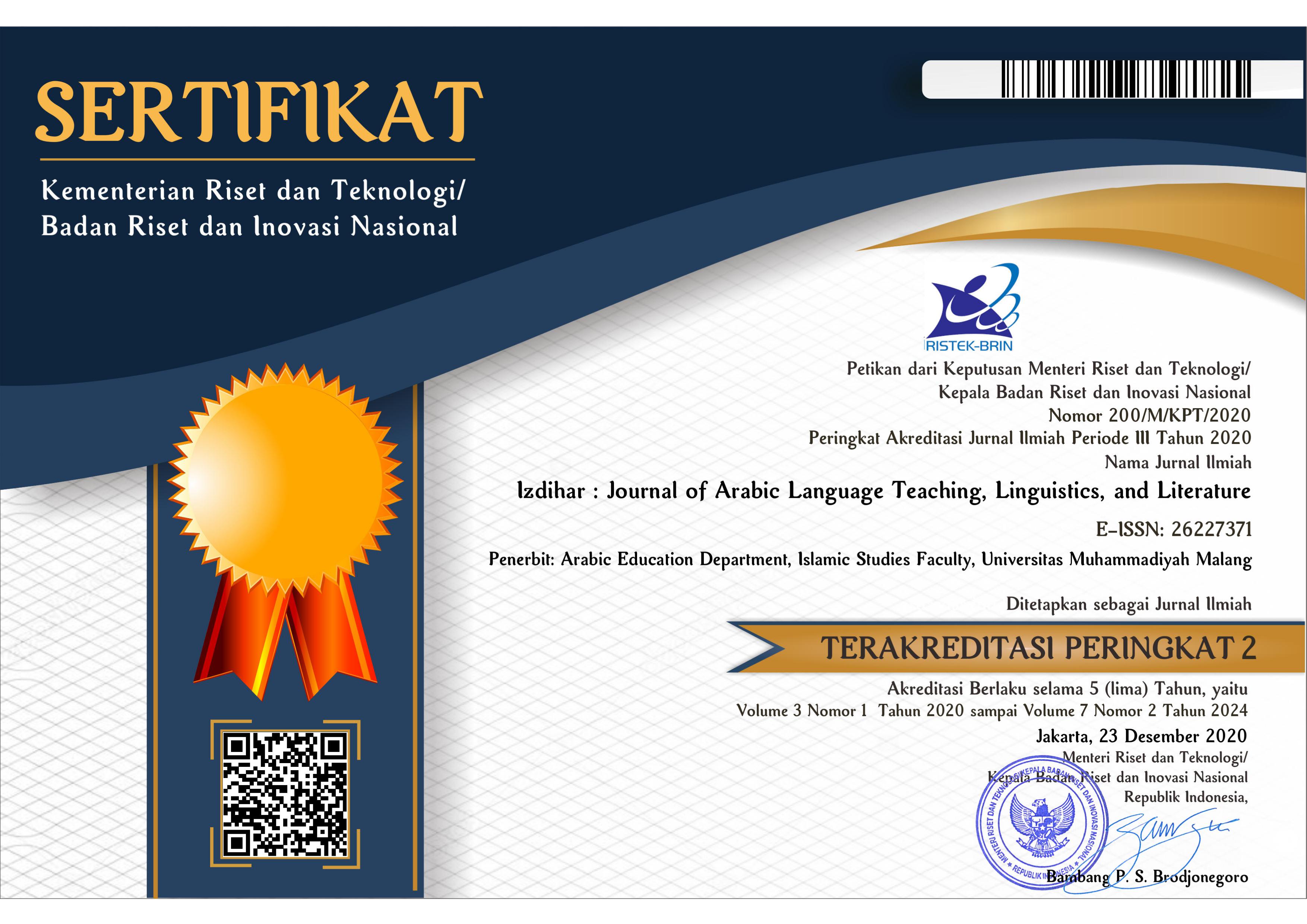Amplification and Description Techniques in the Translation of Arabic Phrases in Matan Al-Ghayah wa Al-Taqrib
DOI:
https://doi.org/10.22219/jiz.v3i2.12337Keywords:
Amplification and Description Technique, Arabic Language Phrase, Aspect of ReadabilityAbstract
The translation from Arabic into Indonesian on the Islamic field has its long history. However, researches on the subject are a little bit rare. Therefore, the study of the item using a modern approach is required. This research described the use of amplification and descriptions techniques in the translation of Arabic phrases in the reading of Matan al-Ghayah wa al-Taqrib by Ahmad Ma'ruf Asrori. Besides, this paper aimed to describe the quality of the text that is seen from the aspect of readability. This research used a qualitative analysis combined with a quantitative data approach. The data were selected and classified based on procedures of translation techniques. The results showed that based on the amplification techniques there were 35 data in Matan al-Ghayah wa al-Taqrib found 35 which can be divided into four Arabic phrases based as follows: 1) 'atfy phrases are 12 data, 2) idhafy phrases are 13 data, 4) syibhu al-jumlah phrases are 5 data, and 5) adjective phrases are 5 data. Whereas in the description technique, the researchers found 31 data divided into five Arabic phrases based on their constituent elements, namely the 'atfy phrase 12 data, idhafy phrase 12 data, ‘adady phrase 3 data, syibhu al-jumlah phrase 3 data, and adjective phrase 2 data. From the translation quality, it showed that the use of these two techniques could be seen from the assessment of the readability aspects of 42 respondents. It rated 52% high readability on the amplification technique, and 56% high readability on the description technique. It means that the translator used more of these two techniques frequently rather than other techniques. It assumed that amplification and description techniques are much more applicable in the translation of Arabic books into Indonesian due to its acceptance of the cultural dimension of the targeted language.
Downloads
References
Al-Munawwir, A. W. (1997). Kamus Al-Munawwir Arab-Indonesia Terlengkap. Yogyakarta: Pustaka Progressif.
Angelone, E. (2010). Uncertainty, uncertainty management and metacognitive problem solving in the translation task. Translation and Cognition, 15, 17–40. DOI: https://doi.org/10.1075/ata.xv.03ang
Arif, A. M. (2019). Analysis of Grammatical Structures of the Translation of KH Basori Alwi in the Book of al-Ghayah wa al-Taqrib. UIN Syarif Hidayatullah.
Arkom, M. (2010). Reduction Strategy in the Translation of the Book of Al-Mawa ’idu Al-Usfuriyah by Muhammad bin Abu Bakar Al-Usfuri (Analysis of Theory and Critical Translations). UIN Sunan Kalijaga.
Asrori, A. M. (2010). Ringkasan Fikih Islam: Terjemah Matan Ghoyah wat Taqrib. Surabaya: Al-Miftah.
Azmy, R. (2015). Teknik dan Metode Penerjemahan Lirik Lagu AKB48 ke JKT48. Humanis, 12(3), 1–8.
Badawi, E. S., Carter, M., & Gully, A. (2004). Modern Written Arabic: A Comprehensive Grammar. New Haven and London: Routledge.
Baker, M. (2018). Translation and Conflict: A Narrative Account. London: Routledge.
Canepa, T. L., Cohen, E. T., & Tang, A. G. (2015, December 15). Flash translation layer with lower write amplification. Google Patents.
Fatoni, A. (2019). Arabic Learning for Academic Purposes. Izdihar: Journal of Arabic Language Teaching, Linguistics, and Literature, 2(2), 149–164. DOI: https://doi.org/10.22219/jiz.v2i2.10096
Fitriah, N. (2017). Translation of the Book of Al-Misbah Fi Bayani Ahkami Al-Nikah by KH. Hasyim Ash’ari. UIN Syarif Hidayatullah.
Fitriyah, T., & Fauzi, M. F. (2020). Improving Quality of Arabic Translation Course through Jigsaw Cooperative Learning. Izdihar: Journal of Arabic Language Teaching, Linguistics, and Literature, 3(1), 17–30. DOI: https://doi.org/10.22219/jiz.v3i1.11033
Hansen, G. (2010). Integrative Description of Translation Processes. In G. M. Shreve & E. Angelone (Eds.), Translation and cognition (pp. 189–212). Amsterdam/Philadelphia: John Benjamins Publishing Company.
Jentoft, N., & Olsen, T. S. (2019). Against the Flow in Data Collection: How Data Triangulation Combined with A ‘slow’ Interview Technique Enriches Data. Qualitative Social Work, 18(2), 179–193. DOI: https://doi.org/10.1177%2F1473325017712581
Kremers, J. (2003). Adjectival Agreement in the Arabic Noun Phrase. Proceedings of Console XI. Available Online at Http://Www. Sole. Leidenuniv. Nl/Index. Php3.
Mahmudin, R. (2015). Fuad Kauma Translation Method Against the Book of Nashaihul Ibad by Sheikh Nawawi Al-Bantani. UIN Syarif Hidayatullah.
Maulidiyah, S. F., Sa’dullah, A., & Hasan, N. (2019). Pembelajaran Kitab Al-Ghayah Wa At-Taqrib Dalam Menguatkan Pemahaman Santri Tentang Thaharah di Pondok Pesantren Thoriqotun Najah Pagentan Singosari Malang. Vicratina: Jurnal Pendidikan Islam, 4(6), 168–174. http://riset.unisma.ac.id/index.php/fai/article/view/3076
Molina, L., & Hurtado Albir, A. (2002). Translation Techniques Revisited: A Dynamic and Functionalist Approach. Meta: Journal Des Traducteurs/Meta: Translators’ Journal, 47(4), 498–512. DOI: https://doi.org/https://doi.org/10.7202/008033ar
Moran-Ellis, J., Alexander, V. D., Cronin, A., Dickinson, M., Fielding, J., Sleney, J., & Thomas, H. (2006). Triangulation and Integration: Processes, Claims and Implications. Qualitative Research, 6(1), 45–59. DOI: https://doi.org/10.1177%2F1468794106058870
Murtadlo, M. (2015). Three Writers of Arabic Texts in Yogyakarta. Heritage of Nusantara: International Journal of Religious Literature and Heritage, 3(1), 107–128. DOI: http://dx.doi.org/10.31291/hn.v3i1.22
Mustain, A. (2015). Problems of Translating Taqrib into Indonesian Santri of Komplek IJ Al-Mashhuriyah Ponpes Al-Munawwir Krapyak Yogyakarta. UIN Sunan Kalijaga.
Nababan, M. R. (2004). Strategi Penilaian Kualitas Terjemahan. Jurnal Linguistik BAHASA, 2(1), 54–65. http://jurnal.um-tapsel.ac.id/index.php/Linguistik/index
Nikolarea, E. (2002). Performability versus Readability. Translation Journal, 6(4). https://translationjournal.net/journal/22theater.htm
Ordudari, M. (2007). Translation Procedures, Strategies and Methods. Translation Journal, 11(3), 8. https://translationjournal.net/journal/41culture.htm
Polkinghorne, D. E. (2005). Language and Meaning: Data Collection in Qualitative Research. Journal of Counseling Psychology, 52(2), 137. DOI: https://psycnet.apa.org/doi/10.1037/0022-0167.52.2.137
Pym, A. (2013). Translation skill-sets in a machine-translation age. Meta: Journal Des Traducteurs/Meta: Translators’ Journal, 58(3), 487–503. DOI: https://doi.org/10.7202/1025047ar
Sprung, R. C., & Jaroniec, S. (2000). Translating into Success: Cutting-edge Strategies for Going Multilingual in a Global Age. Amsterdam/Philadelphia: John Benjamins Publishing.
Toury, G. (1982). A Rationale for Descriptive Translation Studies. Dispositio, 7(19/21), 23–39. https://www.jstor.org/stable/41491224
van Bruinessen, M. (2008). Traditionalist and Islamist pesantrens in contemporary Indonesia. Farish A. https://www.jstor.org/stable/pdf/j.ctt46n10w.12.pdf
Yoyo, Y., & Mukhlis, A. (2019). Historiography of the Arabic Grammar in Europe: The Legacy of Wright’s Arabic Grammar. First International Conference on Progressive Civil Society (ICONPROCS 2019), 212–215. DOI: https://doi.org/10.2991/iconprocs-19.2019.45
Yoyo, Y., Mukhlis, A., Thonthowi, T., & Ferawati, F. (2020). High Variety Vs Low Variety Culture in the Arabic Language: The Tensions between Fushā and ‘Âmiyya in the Contemporary Arab World. Arabi: Journal of Arabic Studies, 5(1), 25–32. DOI: https://doi.org/http://dx.doi.org/10.24865/ajas.v5i1.195
Downloads
Published
How to Cite
Issue
Section
License
Copyright Notice
Authors who publish with this journal agree to the following terms:
- Authors retain copyright and grant the journal right of first publication with the work simultaneously licensed under a Creative Commons Attribution-ShareAlike 4.0 International License that allows others to share the work with an acknowledgment of the work's authorship and initial publication in this journal.
- Authors are able to enter into separate, additional contractual arrangements for the non-exclusive distribution of the journal's published version of the work (e.g., post it to an institutional repository or publish it in a book), with an acknowledgment of its initial publication in this journal.
- Authors are permitted and encouraged to post their work online (e.g., in institutional repositories or on their website) prior to and during the submission process, as it can lead to productive exchanges, as well as earlier and greater citation of published work (See The Effect of Open Access).
Copyright (c) 2019 Izdihar : Journal of Arabic Language Teaching, Linguistics, and Literature

This work is licensed under a Creative Commons Attribution-ShareAlike 4.0 International License.

















